Bulgaria is one of my favourite Eastern European countries. It boasts Orthodox Churches, stunning scenery and medieval castles. It’s also excellent value for money making it a budget backpackers heaven. This Bulgaria itinerary for 10 days takes you from the capital of Sofia, through Bulgaria’s beautiful second city, Plovdiv, and then towards the Bulgarian coast via the Medieval city of Veliko Tărnovo.
Bulgaria – Getting there and away
This Itinerary works best if you can fly into Sofia and out of Varna or Burgas. Here are some of the best and cheapest flights from the UK:
Flights from UK to Sofia, Bulgaria
- Liverpool to Sofia (Ryanair)
- Bristol to Sofia (Ryanair)
- London Stansted to Sofia (Ryanair)
- London Luton to Sofia (Wizz Air)
- Manchester to Sofia (EasyJet)
Flights from Varna or Burgas to UK
- Varna to Liverpool (Ryanair)
- Burgas to London Luton (Wizz Air)
Sofia is one of the best destinations to fly to from Liverpool Airport!
Bulgaria Itinerary for 10 days
This perfect Bulgaria Itinerary for 10 days is summarised as follows:
- Sofia – The Bulgarian Capital City – 3 days
- Plovdiv – Bulgaria’s second city – 2 days
- Veliko Tarnovo – A Medieval town that will take you back in time – 2 days
- Varna – A coastal town on the Black Sea with time to relax on the beach – 3 days
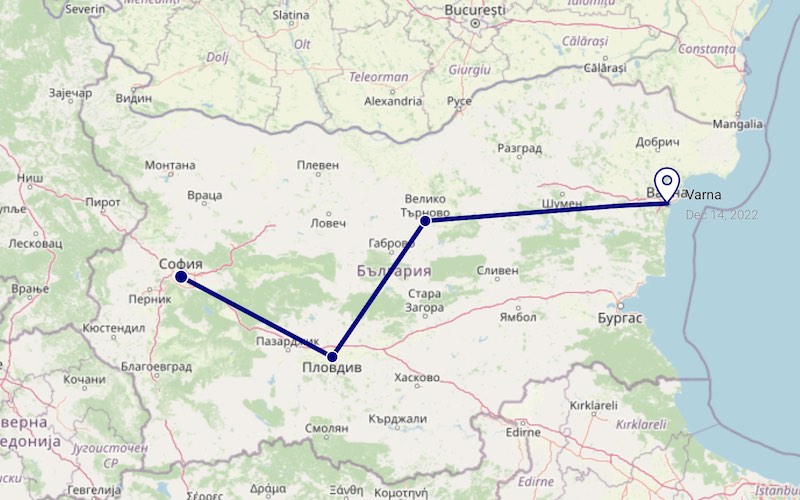
Bulgaria Itinerary for 10 days – Sofia (Day 1-3)
On your first day you will fly into Sofia, the capital of Bulgaria. The city is walkable, easy to navigate and a great initial base to explore Bulgaria and get to know a bit about the food and culture.
Where to stay in Sofia
Budget – Art Hostel – If you are looking for a budget stay go for the Art Hostel, which is also a great place to meet fellow travellers. If you have a healthier budget and you are looking for a comfortable hotel then
Mid Range – If you are looking for a mid-range hotel I recommend the Eurostars Sofia City hotel. It has an excellent breakfast and is just a 5 minute walk from the Alexander Nevski Cathedral.
High End/Luxurious – Looking for a high end and luxurious stay in Bulgaria’s capital? The Hyatt Regency and Inter Continental Sofia are both excellent options and very centrally located.
Sofia Day 1 – Walking tour
On the first day in Sofia you can fit in the following main sights on foot:
- Palace of Justice
- Saint Sunday Church of Sofia
- Sofia Statue
- Serdika Ruins
- Square of Tolerance
- Rotunda of St George
- The Presidency Building: Changing of the Guards Ceremony
- Alexander Nevski Cathedral and Icon Museum (in the Crypt)
- Bars of Sofia – The Apartment
I would highly recommend a walking tour for your first day in Sofia. The tour takes around 3 hours and you can donate whatever you can afford or feel it to be worth. The free Sofia tour meets at the Palace of Justice where you see the Lion statues. This walking tour will take you to see Church Saint Sunday of Sofia, the Saint Sofia Statue, the Serdika Roman ruins, the square of tolerance and the Presidents Palace.
The Serdika Ruins are amazing – when they were digging to build the Metro station in Sofia they discovered more ancient ruins of the Roman city of Serdika including a Roman amphitheatre. These ruins are now displayed in and around the Serdika metro station.
The tour finished at the stunning Alexander Nevski Cathedral, which is probably Sofia’s most famous landmark. The architectural style of the Cathedral is Neo-Byzantine (an architectural revival movement of the 1840’s). The Cathedral is named after Alexander Nevski himself – a Russian Tsar who defended Russia against invading Swedish troops in 1240.
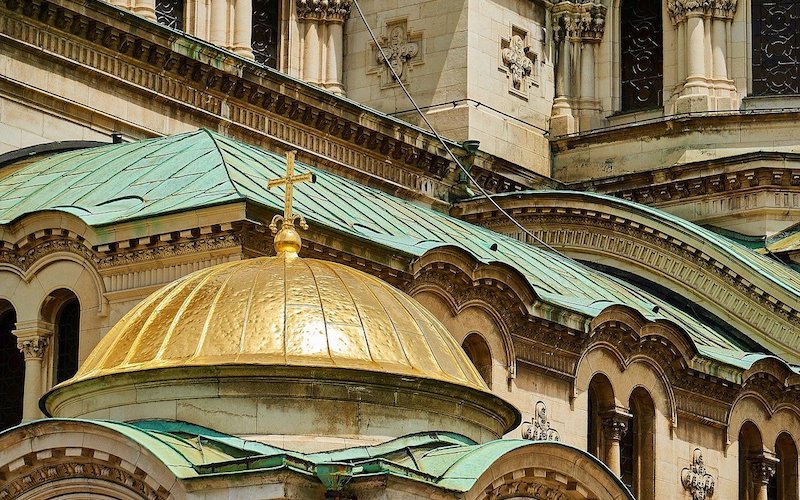
There is a fascinating museum of Religious Art in the crypt – it contains Bulgarian Icons from 4th-19th Century. It’s well worth a visit – not many people realise that it is there. This is the perfect add on to the walking tour and you can then head out to find some nice Bulgarian food and drink.
On the evening check out some of the exciting bars in Sofia such as the Barn, The Apartment and Art Hostel. You might like to read this guide to Sofia Nightlife – it’s a very happening city with a high student population and so Sofia is always a good night out any day of the week.
Sofia Day 2 – Museums, Markets and Gardens
- National Archeological Museum and Museum of Military History
- Central Market Hall
- Borisova Gradina Park ad Sofia City Garden
- Sofia Synagogue
- Bars in Sofia – The Barn
Walk around the ancient city center and explore some of the museums of Sofia including the National Archaeological Museum, the National Museum of Military History, and the Rotunda of St. George.
Stop by the Sofia Central Market Hall, which is a large indoor market that sells a wide variety of fresh produce, meats, cheeses, and other local specialties. You can grab a quick snack or sit down for a meal at one of the many food stalls in the market.
Take a break in one of Sofia’s many parks and gardens. The Borisova Gradina is the largest park in the city and features beautiful greenery, flower gardens, and walking paths. You can also visit the Sofia City Garden, which is a smaller park located in the center of the city and is a popular spot for locals and visitors alike.
Visit the Sofia Synagogue, which is the largest synagogue in Southeastern Europe. The synagogue was built in the early 20th century and features a beautiful Moorish-style architecture. It is an important cultural and historical landmark for the Jewish community in Sofia.
Finish off your second day with a nice meal at The Hadjidragana Tavern and a drink at The Barn.
Sofia Day 3 – Rila Monastery day trip
The Rila Monastery is a historic and cultural landmark in Bulgaria. It is one of the largest and most famous monasteries in the country, and is located in the Rila Mountain range in southwestern Bulgaria. The monastery was founded in the 10th century by the hermit St. John of Rila, and has been a important religious and cultural center for centuries. The monastery is known for its beautiful architectural style and its rich history. It has been a UNESCO World Heritage Site since 1983, and is a must-see destination for anyone traveling to Bulgaria.
It is easy to do Rila Monastery as a day trip from Sofia and I recommend booking with Rila Shuttle. You can get a driver for the Rila Monastery and lakes for around €45. The guides are very knowledgeable and can give you an insight into the area and the history.
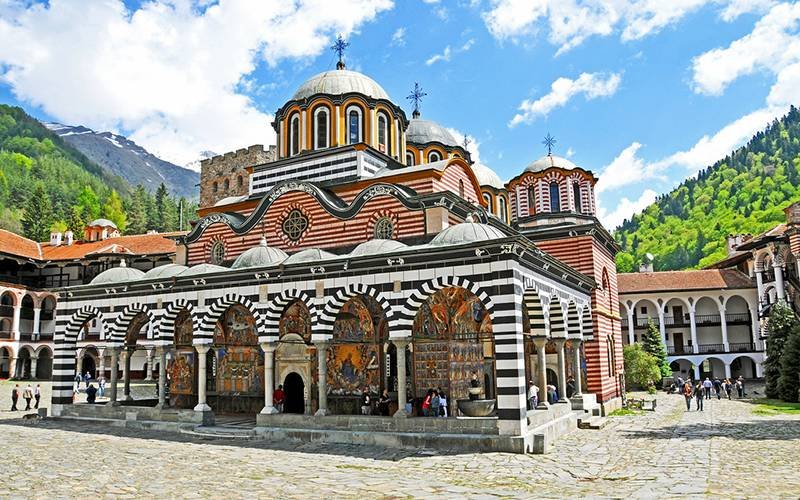
The inside of the Church is stunning – decorated with elaborate gold icons. It is free to enter the Church area, just remember to visit the Church respectfully – remember to observe silence and switch off your mobile phone.
There is an interesting Museum in the Monastery which hosts a number of religious icons and artefacts. This includes many of the rich possessions of the Rila Monastery as well as collections of coins, fabrics and manuscripts. You will need to pay to enter the museum (8 leva) and to go up the tower (5 leva).
While you are visiting, head to the Rila Monastery restaurant where you have the opportunity to eat a freshwater trout which comes from the Rila Lakes. It’s a local delicacy.
From Sofia, you can then take the bus to Plovdiv, a journey which will take you about two and a half hours. There are many services from the main station in Sofia to the main station in Plovdiv including Hebros Bus and Union Ivkoni. You will pay around $6-12. There is a train, but it takes longer (over three hours) and so is not really worth considering unless you have a strong personal preference for train travel.
Bulgaria Itinerary for 10 days – Plovdiv (Day 4-5)
Plovdiv is a city in Bulgaria. It is the country’s second-largest city, with a population of about 614,000 people. Plovdiv is located in central Bulgaria, in the fertile valley of the Maritsa River. The city has a rich history that dates back to ancient times, and it is known for its well-preserved old town, which features a mix of architectural styles from different historical periods. Plovdiv is a popular tourist destination, with many museums, galleries, and cultural events.
Although it is possible to do Plovdiv as a day trip from Sofia if you are pushed for time, this is a city that ideally warrants 2 full days. The historical sites are amazing but it’s also a really artistic city and a great place to hang out and drink coffee!
The city of Plovdiv was built on seven hills either side of the banks of the Maritsa River. Most of the cultural and religious sites (including the Old Town) are positioned to the South of the River. With over 8000 years of history, Plovdiv is considered one of the oldest continuously inhabited cities in Europe.
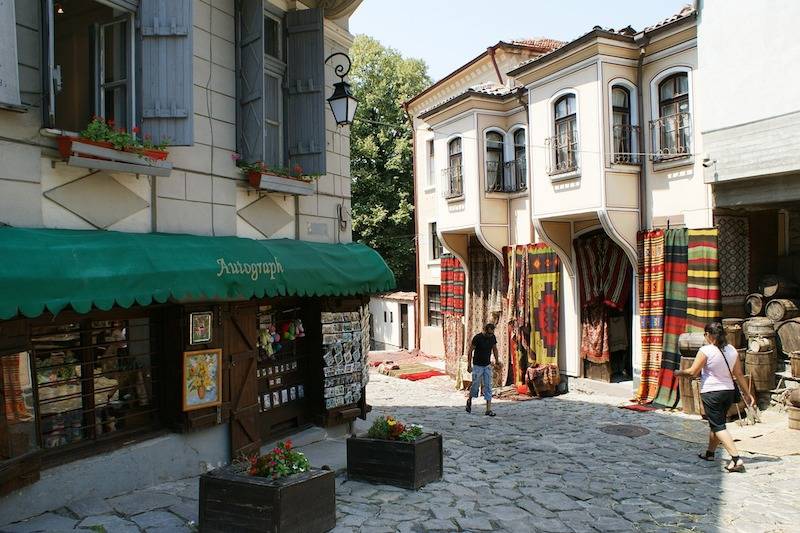
Plovdiv is split into two main halves either side of bul. “Tsar Boris III Obedinitel” (Tsar Boris III Street). On the Eastern side is the Bulgarian revival ‘Old Town’ with ethnographic houses and to the Western side is the Roman ruins and more modern half including Kapana district (the trendy artsy quarter with Street Art). And so it makes sense to visit the revival Old Town on your first day in Plovdiv and the Roman Ruins and Kapana on the second.
Day 4 – Old Town of Plovdiv Historical Houses and Landmarks
Your first day in Plovdiv will allow you to explore the city on foot and visit the following landmarks and monuments:
- Nebet Tepe
- Regional Ethnographic Museum Plovdiv
- St. St. Konstantin and Elena Church
- Balabanov House
- Kuyumdzhioglu House
- Stepan Hindliyan House
- House Museum Klianti
- Zlatyu Boyadzhiev Gallery
- Nedelya Church
Nebet Tepe
Start your tour of Plovdiv with a visit to Nebet Tepe, a historical site located on a hill which will give you panoramic views of the city. Nebet Tepe is believed to have been inhabited since the 6th millennium BC. The hill has been occupied by many different cultures throughout its history, including Thracian, Roman, and Ottoman. Today, Nebet Tepe is a popular tourist attraction, and visitors can explore the remains of the ancient fortifications and structures that were built on the hill. There is no entrance fee to this historic site.
Regional Ethnographic Museum Plovdiv (Kuyumdzhioglu House)
From Nebet Tepe you can walk down to the Ethnographic Museum of Plovdiv, a beautiful revival building that houses in excess of 60,000 artefacts to do with the history of the area. The entrance fee to the museum is 6 leva and there are student and family discounts.
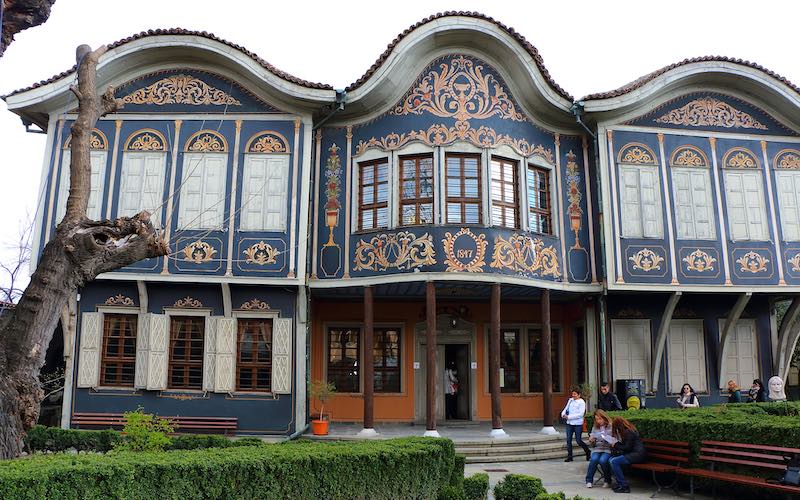
The museum occupies the 1847 house of the merchant, Argir Kuyumdzhioglu, and has done so since 1937. It contains six exhibitions – one in each room of the house:
- Agriculture
- Crafts
- Textiles and Clothing
- Furniture
- Musical Instruments
- Photography and Fine Art
St. st. Konstantin and Elena” Church
Near to the Ethnographic Museum you will find “St. st. Konstantin and Elena” Church – a Church that appears not to be a Church from the outside! Yes, the building is very deceiving, yet astonishingly beautiful inside, so don’t miss it. This is one of the oldest Churches in the city of Plovdiv – there was originally a Church built on this location back in 337 on the site of an ancient pagan temple.
Ethnographic Houses of Plovdiv
Continue to walk through the Old Town, where you will be greeted by a number of ethnographic houses from the 19th Century. They come from the National Revival Period, an era is marked by Bulgaria’s liberation from the Ottoman empire. Plovdiv was also fast developing as a trading centre at this point and so a number of merchants invested in architecture at this time in history. These houses are colourful and characterised by ornate designs and overhanging windows.
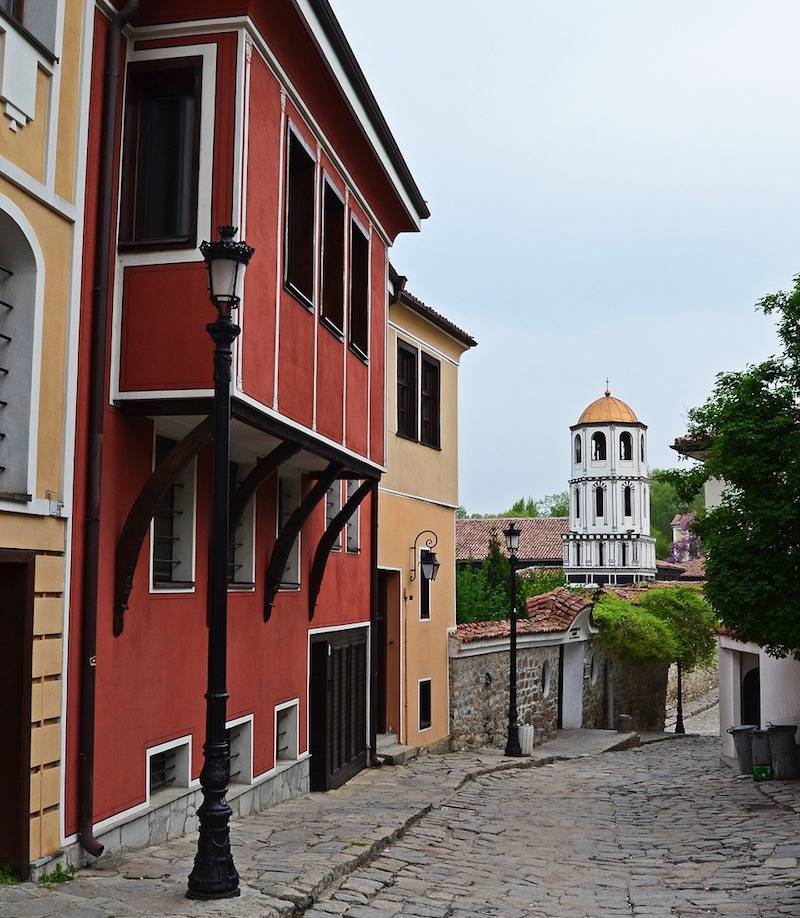
Many of them have been well preserved and converted into museums and so it is well worth spending at least a couple of hours exploring the houses in this district. Some of them have an entrance fee of around 5 leva. In addition to the ethnographic museum, the most popular houses with visitors are:
- Balabanov House
- Stepan Hindliyan House
- House Museum Klianti
- Zlatyu Boyadzhiev Gallery
You can find out more about the Old Town houses of Plovdiv here.
Day 5 – Ancient History and Central Plovdiv
On your second day, start your tour at the ancient theatre of Philippopolis.
- Plovdiv Ancient Theatre of Philippopolis
- Plovdiv Roman Stadium
- Street Art of Kapana
- “Sveta Bogoroditsa” Church
- Djumaya Mosque
- Sveta Marina Church
- Sehat Tepe – Clock Tower
Plovdiv Ancient Theatre
The Ancient Theatre of Plovdiv is a well-preserved Roman theatre. It is one of the largest and best-preserved ancient theaters in the world, and is believed to have been built in the 2nd century AD. The theater was originally used for dramatic performances, concerts, and other public events, and could seat up to 7,000 spectators. Today, the theater is a popular tourist attraction, and visitors can explore the remains of the stage, seating areas, and other structures.
Roman Stadium
The Plovdiv Roman Stadium is a historic site in Plovdiv, Bulgaria. It is one of the best-preserved ancient stadiums in the world, and is believed to have been built in the 2nd century AD. The stadium was originally used for athletic contests and other sporting events, and could seat up to 30,000 spectators. Today, the stadium is a popular tourist attraction, and visitors can walk on the track and explore the remains of the ancient seating areas. The stadium is located in the heart of Plovdiv, with the shopping centre built around it in a fascinating design.
Street Art of Kapana
Then head to one of my favourite Plovdiv Districts – Kapana. This district is enjoyed by creatives and artists. You will find hipster coffee shops, cobbled streets and street art galore. Spend at least an hour enjoying the art and eateries of the area. If you would like to find out more about Kapana, follow this link.
“Sveta Bogoroditsa” Church
“Sveta Bogoroditsa” Church’s full name in English is the Cathedral Church of the Dormition of the Holy Mother of God. It is of particular interest because it is a Bulgarian National Revival Church. It was built in 1844 on the location of a 9th-century shrine. Inside the Church you will find colourful murals and icons, along with an inscription that thanks the liberators of Bulgaria (see this Lonely Planet link).
Djumaya Mosque
The Djumaya Mosque was built in 1363–1364 on the site of the Sveta Petka Tarnovska Cathedral Church after Plovdiv was taken over by the Ottoman army. The building demonstrates classic Ottoman architecture and is one of the few working mosques in Plovdiv. There is a Turkish cafe next to the Mosque which serves a nice Turkish tea.
Sveta Marina Church
This 16th Century Church is worth visiting for the external Old Testament murals on the external walls, including a picture of Adam and Eve. It is an Orthodox Church with a wooden bell tower. There are icons and murals on the inside of the Church as well. It was free to get in last time I was there (approx Jan 2020).
Sehat Tepe – Clock Tower
The Clock tower of Plovdiv is built on one of the hills of Plovdiv called Sahat tepe or Danov’s hill. The tower looks like a 16th Century minaret and was built in 1623. It’s a great place to get some final panoramic views of the city, before you chill with a nice meal and a drink.
You are then ready for your bus to your next destination on your Bulgaria Itinerary of 10 days – Medieval Veliko Tărnovo. The bus will take around three and a half hours. Again, the buses is faster and cheaper than the train and so a better option, You can book via Plovdiv Express or just turn up to the bus station and bus your ticket before you board.
Bulgaria Itinerary for 10 days – Veliko Tarnovo (Day 6-7)
Veliko Tarnovo is a city in Bulgaria that was the capital of the Second Bulgarian Empire in the Middle Ages. It is located in the northern part of the country, along the Yantra River. Veliko Tarnovo is known for its historical and cultural significance, and is often referred to as the “City of the Tsars” because of its association with the medieval Bulgarian emperors. Today, it is a popular tourist destination, with many beautiful old buildings and architectural landmarks, such as the Tsarevets Fortress and the Church of the Holy Ascension.
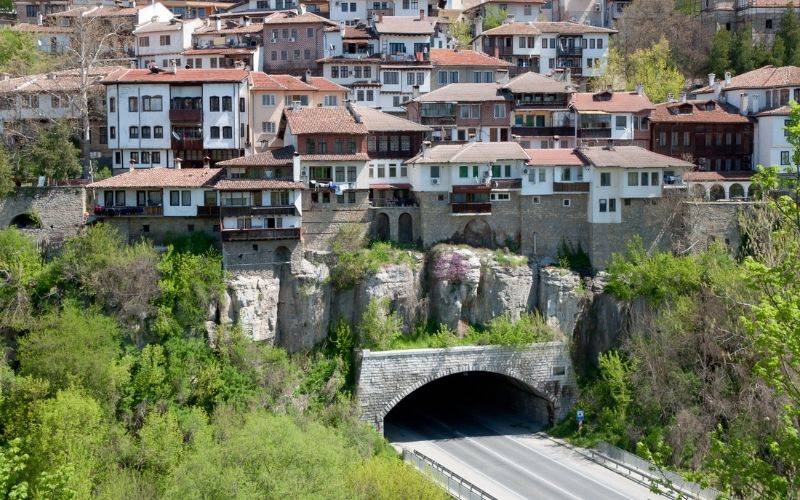
Several travellers that I have spoken to in Bulgaria have rated Veliko Tărnovo as their top destination. If you are a history fan, it’s easy to see why. This medieval town was the capital of Bulgarias empire during the 11th and 12th Centuries.
Day 6 – Arbanasi and Tsaravets
Your first Day in Veliko Tărnovo will involve you heading straight to Arbanasi and Tsaravets to explore the Castles and Churches of the area. As transport is infrequent and limited in this area, it is a good idea to book a tour that incorporates both of these destinations. Arbanasi is about 10km outside of the downtown area of Veliko Tărnovo. The local bus takes about 15 minutes to get from Abanasi to Tsaravets. Here is a list of your main sites for the first day:
- Nativity Church and Monastery
- Church of Saints Archangels Michael and Gabriel
- Konstantsalieva House
- St. Nicholas Convent
- Tsaravets Fortress
- Ascension Cathedral
- Baldwins Tower
- Holy Forty Martyrs Church
- Trapezitsa Fortress
- Church of Saint Demetrius of Salonica
Abanassi
Abanasi is a small village the other side of Tsaravets that is home to some interesting Churches and historical buildings.
Chiesa della Nativita
The first is the Nativity Church and Monastery – Chiesa della Nativita. It appears to be a simple house, but it actually contains a Church with opulent frescos that line the surface of the interior walls. During the Ottoman occupation it was forbidden to build Churches higher than houses and this was the response.
Church of Saints Archangels Michael and Gabriel
The second stop is another Church lined with frescoes – the Church of Saints Archangels Michael and Gabriel. It was built around the late 15th to early 16th Century and although it is not as ornate as the Church of the Nativity (and the frescoes or a few hundred years younger) it is still worth a visit especially if you have a guide.
Konstantsalieva House
This 17th century house, has been beautifully restored in style of the National Bulgarian Revival.
St Nicholas’ Convent
This 13th century convent was actually demolished in 1393 when Tarnovo was conquered by the Ottomans. It was then renovated and restored in 1680. It is a fully functional convent that is still working today and a ‘miracle-working Mary’ is found in the chapel.
Tsaravets and Trapezitsa
After lunch, hop on the local bus or travel with your guide from Arbanasi to Tsaravets to indulge yourself in more Churches and Fortresses – what a treat?!?
Tsaravets Fortress
No doubt you will be excited and eager to head to Tsaravets for a view of the stunning medieval fortress which was stronghold for the second Bulgarian empire. The cost to enter the fortress is just 6 leva. As well as the Medieval fortress, one of the main attractions is the Ascension Cathedral (known informally as the ‘Church on the Hill’).
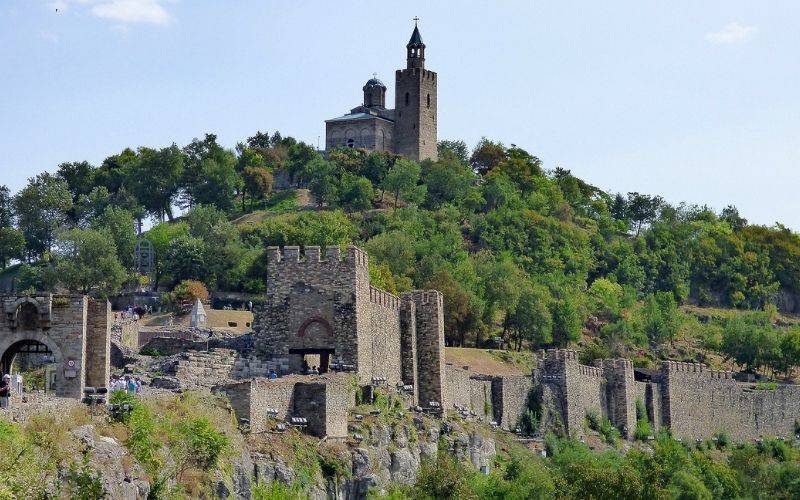
Baldwins Tower
To the Southeast of Tsaravets fortress is a square tower known locally as Baldwin’s tower. Rumour has it that the Latin Emperor Baldwin I of Constantinople was held prisoner here until his execution in 1206.
Mini Bulgaria Park
If you want something relaxing and enjoyable for all the family then while you are in this area check out the Mini Bulgaria Park. It contains miniatures of the most famous buildings in Bulgaria (made from PVC) including Alexander Nevski Cathedral in Sofia, Euxinograd Palace in Varna and Tsarska Bistritsa in Borovets. Discover the whole of Bulgaria in just one hour!
Trapezitsa Fortress
If you are not ‘completely fortressed out’ at this point then cross the river to explore another Medieval Fortress – Trapezitsa Fortress, along with the Church of Saint Demetrius of Salonica.
It’s now time to head back to Veliko Tărnovo to rest up for day 2 – man, that was a lot of Churches and Fortresses today! Two restaurants that I highly recommend in Veliko Tărnovo are Restaurant Shtastliveca and Restaurant Asenevtsi.
Day 7 – Monuments of Downtown Veliko Tarnovo
Today you will spend the morning in downtown Veliko Tărnovo exploring some of the historical monuments and Churches there. You will also get some panoramic views of the city from the Skywalk and Observation deck. Then you will be able to enjoy some relaxing time eating and drinking, before you move onto the next destination on your Bulgaria Itinerary for 10 days – Varna.
Make sure that you explore the following:
- St Nikolay Church – An Orthodox Church with a Bell tower and internal frescoes
- Skywalk EASA – The Skywalk was built in 2014 as a result of the annual European Union Architecture summer project. It gives you the best views of Veliko Tărnovo.
- Monument to the Assen Dynasty – This monument was built in 1985 and dedicated to the kings Assen, Peter, Kaloyan and Ivan Assen II.
- Memorial of Nikola Nikolov – Memorial monument to remember Nikola Nikolov in Seta Gore Park.
- Statue of Stephan Stambolov – Prime Minister of Bulgaria from 1887 to 1894.
- Monkey House – A fine example of revival architecture in Veliko Tărnovo – built in 1849 by Kolyu Ficheto.
- Monument of Mother Bulgaria – Monument dedicated to the Bulgarians killed in the wars of Bulgarian history including the Russo-Turkish, the Serb-Bulgarian, the Balkan and the First World Wars.
Bulgaria Itinerary for 10 days – Varna (Day 8-10)
The final stage of your Bulgaria 10 day itinerary takes you to the Black Sea Coast. Varna is a city on the Black Sea coast of Bulgaria. It is the third-largest city in the country, with a population of around 400,000 people. Varna is an important economic, cultural, and tourist center, known for its beaches, historical landmarks, and vibrant nightlife. The city is home to many museums, galleries, and cultural institutions, as well as a number of important festivals and events, such as the Varna Summer International Music Festival and the Varna Film Festival. Varna is also a major port and transportation hub, with a large airport and a major shipping and industrial center.
Day 8 – Historical sites of Varna
Your first day in Varna will be walking around the city centre and visiting the following main sites:
- Varna Roman Baths – Roman ruins of ancient thermal baths in the centre of Varna.
- Archaeological Museum of Varna – Housed in a Neo-Renaissance style building that used to be an old school. t contains exhibits on the prehistoric, Thracian, Ancient Greek and Ancient Roman periods of Bulgarian history.
- Dormition of the Theotokos Cathedral – The largest religious building in the city of Varna and the third largest Cathedral in Bulgaria.
- Primorski Park – A relaxing city park known locally as ‘the sea garden’ or the ‘seaside garden’
- The Port – Explore the harbour of Varna where the ships come in.
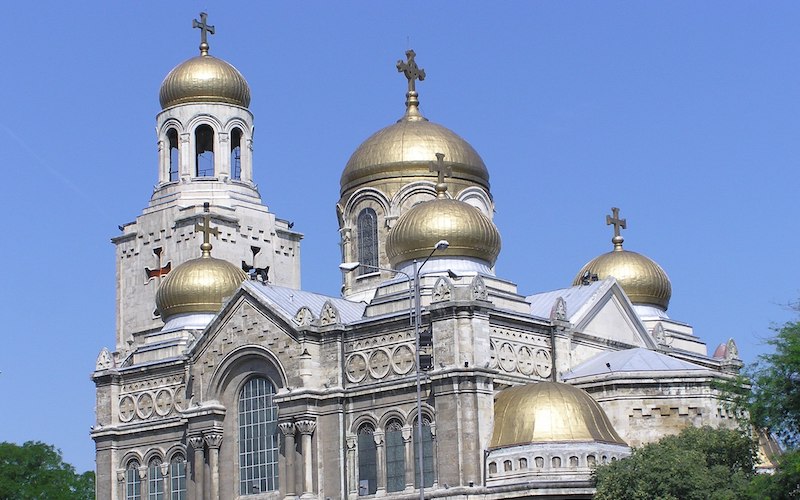
After your first day of walking around the city you will be ready for a well-deserved drink. Head to my favourite bar in Varna – Kultura Speakeasy.
Day 9 – Day trip to Aladzha Monastery
On your second day in Varna, take a trip 17km along the coast to the Aladzha Monastery – a cave Monastery complex that dates back to the 12th Century. A nearby cave monastery complex has even been suggested that it dates back to 5th Century! The monastery caves were carved into a 25-m high vertical cliff! You might like to combine this trip with a coastal walk along the Golden Sands.
Day 10 – Relaxing Beach Day
Varna is the perfect destination to end your Bulgaria Itinerary for 10 days, because the beautiful beaches will ensure that you get some relaxing time before heading home. Check out Varna Beach and Rappongi Beach. There are some great cocktail bars along the front.
If you are still up for more adventure and want to exchange your beach day for another castle, then you could consider heading inland to discover Ovech Fortress.
Add on – Burgas
If you would like to extend your time in Bulgaria why not consider a Burgas add-on? Personally I prefer Varna to Burgas because it has an older historical centre. However, if you have 12 days to two weeks to spend in Bulgaria then Burgas has a lovely beach for some end of travel relaxing. Burgas is also a good base destination for more day trips.
Bulgaria Itinerary for 10 days – Further Reading
If you enjoyed this Bulgaria Itinerary for 10 days, you might also enjoy some of these articles on travel in Bulgaria….
Bulgaria is a phenomenal country with castles and Churches galore, whilst proving excellent value. How did you get on with your trip? I’d love to hear all about it – drop me a comment below!
